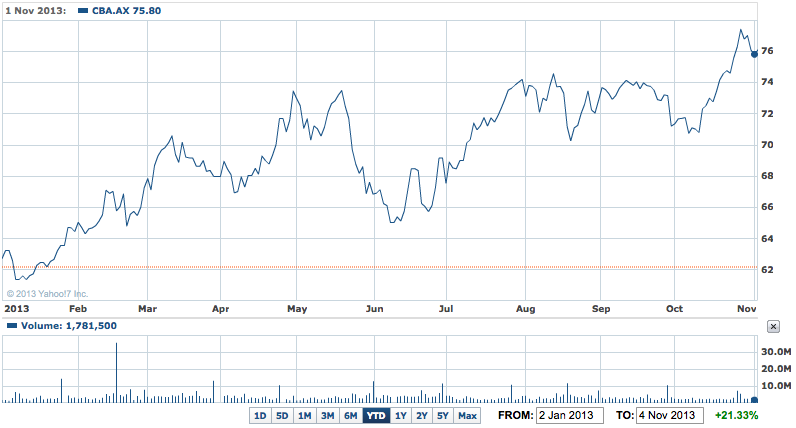For all those investors worried about the sustainability of the current bull run in banks at these very high share prices (and whether the banks remain good value), the first quarter trading update from the Commonwealth Bank (CBA) provides more fodder for their concerns, but also a solid amount of re-assurance.
As we pointed out a month or so ago, much of the rise in profits by the big four banks has been driven by falling bad and doubtful (impaired) asset provisioning – as we saw especially in the cases of Westpac and the NAB in their full year results.
It also helped the CBA for the 12 months ending June 30, and there was again a benefit in yesterday’s Q1 trading update, except the impact was rather small.
The CBA reported a cash trading profit of $2.1 billion for the September quarter, up from $1.85 billion for the September quarter of 2012.
That’s an increase of around $250 million, or 14%, representing an acceleration on previous growth rates because in the year to June, it lifted cash earnings 10% to an all time high of $7.8 billion profit this year, which was also the highest profit result ever for an Australian bank.
The CBA yesterday revealed that its bad debt provision for the quarter had dipped $63 million to $228 million, from $293 million.
That means the other $187 million or more in higher trading profit came from increased income from lending and fees – even though its net interest margin tightened a fraction. Cost cuts also helped boost earnings.
Many investors wonder if the banks can continue to cut their bad and doubtful debt provisions and use the savings to boost profits and dividends. It has worked now for three years, and the question now is, will it work heading into 2014.
The bad and doubtful debt provision is a very low 0.16% of gross loans outstanding, which with unemployment starting to rise, seems too low.
And Its impaired assets fell to a total of $4.28 billion, which sounds a lot, but isn’t when the bank has over $400 billion of loans. The CBA said it had maintained "strong" levels of provisioning for bad debts.
But the bank said mortgage areas fell in the quarter, while arrears in consumer lending, such as credit cards, were stable.
But there’s also a lot of reassurance is in the substantial gain in income other than the fall in the bad debt provision by the CBA in the quarter, which means the bank is doing OK.
No wonder the shares jumped to an all time intra-day high of $78.40 yesterday, before they eased back to still end higher at $77.96, for a gain of 96c or 1.2% on the day.
CBA YTD – Commonwealth update confirms record price rises

Based on this one quarter, analysts reckon the bank will earn more than $8.2 billion for the year to June 2014 (assuming no material problems emerge).
In its statement yesterday, the CBA said the "key outcomes for the quarter are summarised below:"
• A combination of solid revenue growth and cost discipline resulted in positive “jaws” in the quarter;
• Group Net Interest Margin was marginally lower than the prior half, reflecting deposit margin compression in a lower interest rate environment;
• Trading income remained at relatively strong levels;
• System mortgage credit growth was modest, with the Group growing slightly ahead of system. Whilst lower interest rates have supported strong growth in new business activity compared to the prior year, this has been balanced by higher levels of loan repayments;
• Commercial lending growth reflected low system credit growth in the quarter;
• Household deposit growth remained strong and broadly in line with system;
• Strong investment performance in rising equity markets contributed to Funds under Administration and Assets under Management growing by 4 per cent in the quarter, with FirstChoice and Custom Solutions achieving combined net flows of $0.9 billion. Insurance inforce premiums increased by 2 per cent with General Insurance and Direct Life benefiting from continued sales momentum in Retail Bank channels;
• Credit quality remained sound, with arrears rates lower in home lending and stable in unsecured consumer lending. Impaired assets were marginally lower at $4.28 billion. Strong provisioning levels and coverage ratios were maintained, with the economic overlay unchanged. Total impairment expense was $228 million in the quarter;
• Strong liquidity and funding positions were maintained, with liquid assets standing at $137 billion, customer deposit funding at 64 per cent and the average tenor of the wholesale funding portfolio unchanged at 3.8 years;
• The Group’s Internationally Harmonised Common Equity Tier 1 (CET1) ratio was 10.7 per cent as at 30 September 2013, compared to 11.0 per cent in June 2013. Continued strong organic capital generation in the quarter was offset by the declaration of the 2013 final dividend, which had a negative impact of 109 basis points in the period; and
• The New Zealand economy continued to show signs of improvement, with a stronger household sector underpinning a broad-based expansion in activity. ASB recorded solid growth in both customer advances and deposits in the quarter. Whilst retail deposit margins improved, lending margins remained under pressure in a competitive market.
The upshot from that detail is that the CBA got solid revenue growth in the quarter, and a lot of that dropped to the bottom line, to go with the lower bad debt provision. At a time when rates are low and lending growth is weak, it’s a solid achievement.













